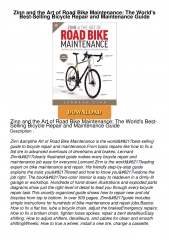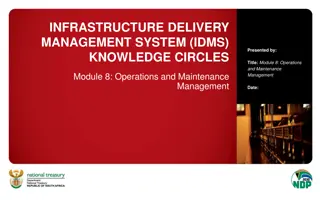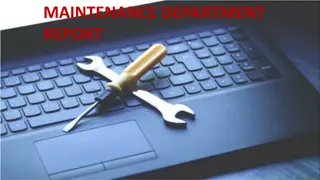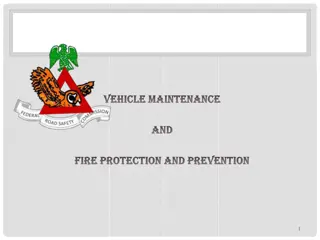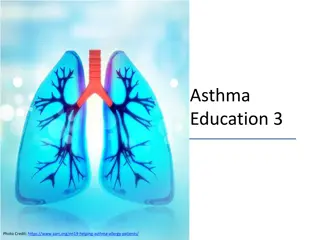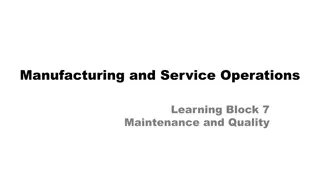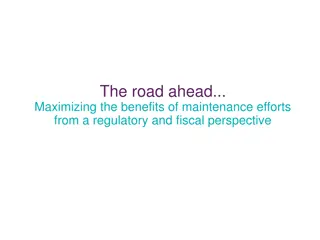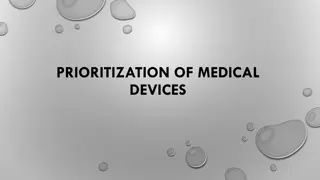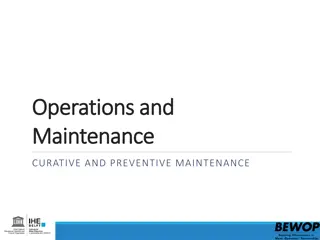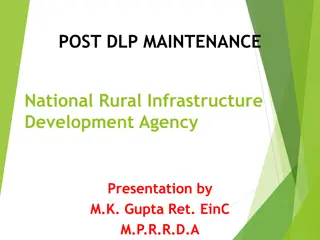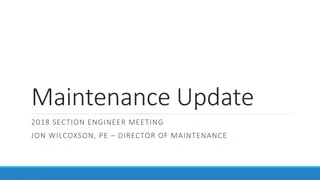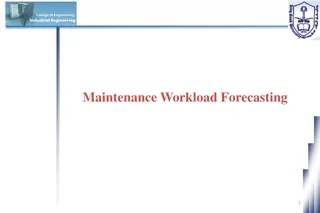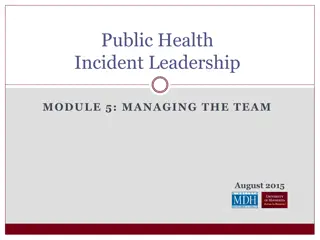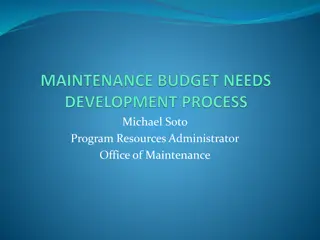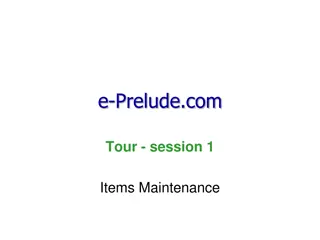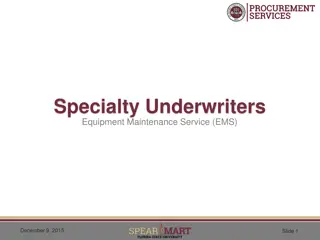Understanding Maintenance Management: Objectives and Types
Introduction to maintenance management involves the work of keeping equipment in proper condition to prevent failure and ensure optimal functioning. Objectives include minimizing maintenance costs and deciding on equipment replacement. Types of maintenance include breakdown (reactive), preventive, and predictive, each with its advantages and disadvantages.
Download Presentation

Please find below an Image/Link to download the presentation.
The content on the website is provided AS IS for your information and personal use only. It may not be sold, licensed, or shared on other websites without obtaining consent from the author. Download presentation by click this link. If you encounter any issues during the download, it is possible that the publisher has removed the file from their server.
E N D
Presentation Transcript
Maintenance Management PRERNA TOSHNIWAL
Introduction to Maintenance Management The dictionary defines maintenance as the work of keeping somethingin proper condition, upkeep. This would imply that maintenance should be taken to prevent a device or component from failing or to repair normal equipment degradation experienced with the operation of the devices to keep it in proper working order. Data obtained in many studies over the past decade indicates that most private and govt. facilities do not expend the necessary resources to maintain equipment in proper order. They wait for equipment failure tooccur and then take whatever actions are necessary. Nothing lasts forever and all equipment has some predefined expectancy or operationallife.
Objectives of Maintenance Equipments should be kept in the best operating conditionwith economical cost. Minimize cost of maintenance If a firm wants to be in business competitively, it has to take decisionon whether to replace the equipment or to retain the oldequipment.
Types of Maintenance Breakdown (Reactive) Maintenance It is basically the run it till it breaks maintenance mode. No actionsor efforts are taken to maintain the equipment as the designer originally intended to ensure design life is reached. Advantages: Involves low cost investment. 1) Less staff is required. 2) Disadvantages: Increased cost due to unplanned downtime ofequipment. 3) Increased labour cost, if overtime is needed. 4) Cost involved with repair or replacement of equipment. 5) Possible secondary equipment or process damage from equipment failure. 6)
Preventive Maintenance it can be defined as Actions performed on a time or machine-run-based schedule that detect, preclude, or mitigate degradation of a component or system with the aim of sustaining or extending its useful life through controlling degradation to an acceptable level. Advantages: Cost effective in many capital intensive processes. (12% to18%) 1) Flexibility allows for the adjustment of maintenance periodicity. 2) Increased component life cycle. 3) Energy savings. 4) Reduced equipment or processfailure. 5) Disadvantages; Catastrophic failures still likely to occur. 1) Labour intensive. 2) Includes performance of unneeded maintenance. 3)
Predictive Maintenance It can be defined as Measurements that detect the onset of a degradation mechanism, thereby allowing casual stressors to be eliminated or controlled prior to any significant deterioration in the component physical state. Results indicate current and future functional capability. It differs from preventive maintenance by basing maintenance need on the actual condition of the machine rather than on some preset schedule. Advantages: Increased component operational life. Allows for pre-emptive corrective actions. Decrease in equipment or process downtime. Decrease in costs for parts and labour. Better product quality. Energy savings. Improved worker and environmental safety. Disadvantages: Increased investment in diagnostic equipment. Increased investment in staff training. 1) 2) 3) 4) 5) 6) 7) 1) 2)
Concept of Reliability in Maintenance Reliability is the probability of survival under a given operating environment. Ex; The consecutive failures of a refrigeratorwhere continuous working is required is a measure of itsreliability. Reliability or Failure rate= No. of units survived till the specifictime Total no. of units used
Reliability Improvement Improved design of components. Simplification of product structure Usage of better production equipments Better quality standards Better testing standards Sufficient number of standby units Usage of preventive maintenance if necessary at appropriate time.
Maintenance Planning Steps Knowledge base : t includes knowledge about equipment, job, available techniques, materials and facilities. Job investigation at site: It gives a clear perception of the total jobs. Identify and document the wok: Knowing the earlier two steps and knowing the needs of preventive, predictive and other maintenance jobs. Development of repair plan: Preparation of step by step procedures which would accomplish the work with the most economical use of time, manpower and material. Preparation tools and facilities list: Indicating the needs of special tools, tackles and facilities needed. Estimation of time required to do the job: with work measurement technique and critical path analysis.
Maintenance Scheduling Scheduling is the function of coordinating all of the logistical issuearound the issues regarding the execution phase of work. It deals with the questions- Who would do the job? and When the job would be started and done? Requirements for schedulers: Manpower availability by trade, location, shift, crew arrangementand permissible overtime limit etc. Man hour backlog on current or unfinishedjobs. Availability of the equipment or area where the work has to bedone. Availability of proper tools, tackles, spares, consumables, structuraland other required materials. Availability of external manpower and their capabilities. Availability of special equipments, jigs, special lifting and handling facilities and cranes etc. Stating and completion date and time of jobs. Past schedules and charts (updated). 1) 2) 3) 4) 5) 6) 7) 8)
Maintenance Schedule Techniques The first step of all scheduling is to break the job into small measurable elements, called activities and to arrange them in logical sequences considering the preceding, concurrent and succeeding activities. The various techniques are: Weekly general schedule is made to provide weeks worth of work for each employee in an area. Daily schedule is developed to provide a day s work for each maintenance employee of the area. Gantt charts are used to represent the timings of tasks required to complete a project. Bar charts used for technical analysis which represents the relative magnitude of the values. PERT/CPM are used to find the time required for completion of the job and helps in the allocation of resources. 1) 2) 3) 4) 5)
Modern Maintenance Methods Reliability Centered Maintenance (RCM) It recognises that all equipments in a facility is not of equal importance to either the process or safety. This indicates that equipment design and operation differs and that different equipment will have a higher probability to undergo failures from degradation. A facility does not have unlimited financial and personnel resources and that its use should be prioritizedand optimised. Advantages: Lower costs by eliminating unnecessary maintenance. 1) Reduced probability of sudden equipment failures. 2) Increased component reliability. 3) Incorporates root cause analysis. 4) Disadvantages: Can have significant startup cost, training, equipmentetc. 1) Savings potential not readily seen by management. 2)
Six sigma Maintenance It is a process that focuses on reducing the variation in business production control i.e. a tighter control over its operational systems, increasing their cost effectiveness an encouraging productivity breakthrough. It is a term created by MOTOROLA to describe the goal and process used to achieve levels of quality improvement. Steps: This six sigma process is also known as DMAIC process. The steps are: Define (Determining benchmarks, availability and reliability requirements, mapping the flow process) Measure (Development of failure measurement techniques, data collection , compilation and display) Analysis (Checking and verifying the data and drawing conclusions, improvement opportunities, finding root causes) Improve (creating model equipment and maintenance process, plan and schedule and implement those) Control (Monitoring the improved programme, performances, make necessary adjustments for deviations) 1) 2) 3) 4) 5)
Enterprise Asset Management(EAM) It is an information management system that connects all departmentsand disciplines within a company making them an integrated unit. It is an organised and systematic tracking of an organisation s physical assets(plant, machinery).It reduces paperwork, improves quality, quantity and timeliness of information. Lean Maintenance This system recognises seven forms of waste in maintenance. They are over production, waiting, transportation, process waste, inventory, waste motion and defects. Efforts are made for the continuous improvement in process by eliminating wastes. It leads to maximise yield, productivityand profitability.
Computer Aided Maintenance Such systems serve as effective decision support tool in the form of a well designed information system. Programmes are prepared to handle a large volume of data pertaining to men, money and equipment and can be used as and when required for effective performance of maintenance tasks. Computer based maintenance systems: Job card system Job card shows the plant code, equipment code, job code, the nature of the jobs, the start time and finishing time, man-hour spent and etc. The use of computer facilitates the issue of job cards, recording job history and control of manpower. Spare part life monitoring system This is the recording of a description, anticipated life and date of installation of an equipment. When a spare part is replaced during breakdown failures or scheduled maintenance, the updating of information is done. Spare parts tracking system- A file is created that contains the material code, spare part identification number, the assembly number and the place of part used. This helps in knowing the current position about a particular spare part and facilitates timely requirements. 1) 2) 3)
Total Productive Maintenance (TPM) The goal of TPM is to increase production while, at the sametime, increasing employee morale and job satisfaction. The goal is to hold emergency and unscheduled maintenance to a minimum. It can be considered as a medical science of machines. Objectives of TPM: Avoid wastage in a quickly changing environment. 1) Producing goods without reducing productquality. 2) Reduce cost. 3) Produce a low batch quantity at the earliest possibletime. 4) Goods send to the customers must benon-defective. 5)
Similarities between TPM & TQM (Total quality Management) Total commitment to the program by upper level management is required in both programmes. 1) Employees must be empowered to initiate corrective action. 2) A long-range outlook must be accepted as TPM may take a yearor more to implement and is an on-goingprocess. 3) Difference between TPM & TQM Category TQM TPM Object Quality (output and effects) Systemize the management It is software oriented Equipment (Input and cause) Employees participation Hardware oriented Mains of attaining Goal Target Quality for PPM (Power production management0 Elimination of losses and wastes
Pillars of TPM 5S Autonomous Maintenance Kaizen Planned Maintenance Quality Maintenance Training Office TPM Safety, Health & Environment
Pillar 1- 5S Problems cannot be clearly seen when the work place isunorganised. Cleaning and organising helps the team to uncover problems. This isthe first step of improvement. SEIRI Sort Out (Sorting and organising the items as critical,important, frequently used items, useless, or items that are not in need) SEITON Systematise (Each item has a place and only one place.Items should be placed back after use) SEISO Sweep (Cleaning the workplace free of burrs, grease, oil, waste, scrap etc. No loosely hanging wires or oil leakage frommachines) SEIKETSU Standardise (Employees have to discuss together and decide on standards for keeping the workplace/ machines/ pathways neat and clean) SHITSUKE Self-discipline (This self-discipline rule includes wearing badges, following work procedures, punctuality, dedication to the organisation)
Pillar 2 Jishu Hozen (Autonomous Maintenance) This pillar is geared towards developing operators to be able to takecare of small maintenance tasks, thus freeing up the skilled maintenance people to spend time on more value added activity and technicalrepairs. Steps in Jishu Hozen: Train the employees Initial cleanup of machines Counter measures Tentative standard General inspection Autonomous inspection Standardization Autonomous management 1) 2) 3) 4) 5) 6) 7) 8)
Pillar 3 - Kaizen Kai means change, and Zen means good (for the better). Kaizen is for small improvements, but carried out on a continual basis andinvolve all people in the organisation. It requires little or noinvestments. Kaizen Policy: Practice concepts of zero losses in every sphere ofactivity. 1) Relentless pursuit to achieve cost reduction targets in all resources. 2) Relentless pursuit to improve overall plant equipment effectiveness. 3) Extensive use of PM analysis as a tool for eliminating losses. 4) Focus of easy handling of operators. 5)
Tools used in Kaizen: PM analysis 1) Why-Why analysis 2) Summary of losses 3) Kaizen register 4) Kaizen summary sheet 5) 16 Major losses in an organisation: 9) Scheduled downtime loss Breakdown loss 1) Adjustment loss 2) 10) Operating motion loss Cutting blade loss 3) 11) Line organisation loss Start up loss 4) 12) Logistic loss 13) Measurement loss Idling loss 5) Speed loss 6) 14) Energy loss 15) Die, jig and tool breakage loss 16) Yield loss Rework loss 7) Management loss 8)
Pillar 4 Planned Maintenance It is aimed to have trouble free machines and equipments producing defect free products for total customer satisfaction. Policy: Achieve and sustain availability of machines Optimum maintenance cost Reduces spares inventory Improve reliability and maintainability of machines. 1) 2) 3) 4) Steps: Equipment evaluation and recoding present status. Restore deterioration and improve weakness Building up information management system. Prepare time-based information system, select equipment. Prepare predictive maintenance system by introducing equipment diagnostic techniques. Evaluation of planned maintenance. 1) 2) 3) 4) 5) 6)
Pillar 5 Quality Maintenance It is aimed towards customer delight through highest quality bydefect free manufacturing. Transition is from reactive to proactive (Quality control to quality assurance). Policy: Defect free conditions and control of equipments. 1) QM activities to support quality assurance. 2) Focus of prevention of defects at source. 3) Focus on fool proof system. 4) In-line detection and segregation of defects. 5) Data Requirements Customer end line rejections 1) Field complaints 2)
Pillar 6 - Training It is aimed to have multi-skilled revitalized employees whose morale is high and who is eager to come to work and perform functions independently and effectively. Education is given to operators to upgrade their skill. Policy: Focus on improvement of knowledge, skills and techniques. Creating a training environment for self learning based on feltneeds. Training curriculum/tools/assessment etc. Training to remove employee fatigue and make workenjoyable. Steps: Preparation of training calendar. Evaluation of activities and study of future approach. Setting training policies and establish training systems. Up gradation of operation and maintenanceskills. 1) 2) 3) 4) 1) 2) 3) 4)
Pillar 7 Office TPM Office TPM should be started after activating four other pillars ofJH, KK, QM,PM. This includes analyzing processes and procedures towards increased office automation. 12 major losses of Office TPM 1) Processing loss 2)Cost and Inventory loss 3) Communication loss 4)Idle loss 5)Set-up loss 6) Accuracyloss 7) Office equipment breakdown 8) Communication channels loss 9) Time loss on information 10) Non availability of stock status 11) Customer complaints 12) Expenses on emergency Benefits of Office TPM 1) Involvement of all people 2) Better utilised work area 3) Reduced repetitive work 4) Reduced inventory levels 5) Reduced administrative cost 6) Less inventory carrying cost 7) Reduction in number of files 8) Reduction of overhead costs 9) Productivity of people 10) Clean work environment 11) Less customer complaints 12) Reduced manpower
Pillar 8 Safety, Health & Environment Target: Zero accident 1) Zero health damage 2) Zero fires 3) A safe workplace and a surrounding area that is not damaged by our process or procedures. This pillar will play an active role in each of the other pillars ona regular basis. Utmost importance to safety is given to the plant.


